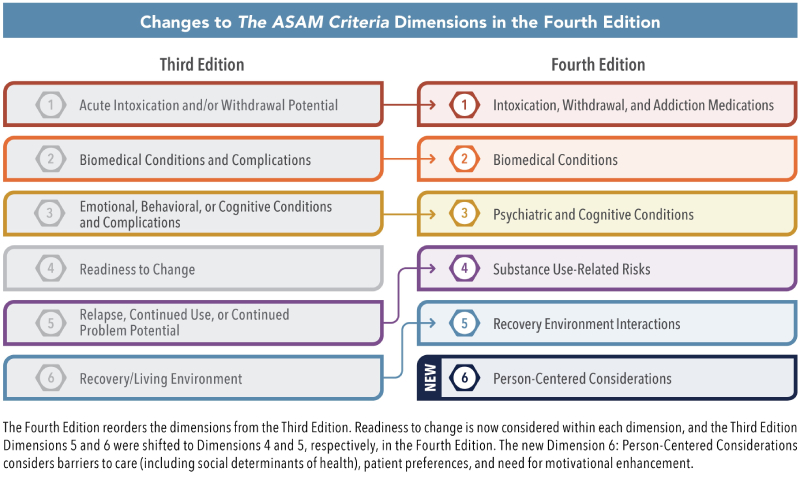Treatment
Treatment services for individuals with a substance use disorder diagnosis include assessment, the development of a treatment plan, implementation of the treatment plan, evaluation, case management, extended care, and monitoring. Programs vary in length and intensity, and they may include approaches like medical stabilization/detox, counseling and behavioral healthcare, and rehabilitation services. In treatment, the ASAM Criteria (American Society Of Addiction Medicine) is the most widely used and comprehensive set of standards for placement, continuation of services, and determining levels of care for individuals seeking treatment for substance use disorder. Level of care recommendations and treatment plans are developed based on multidimensional patient assessments that consider the patient’s medical, psychological, and social needs to help determine what services are a best fit to meet individual and/or patient needs. Additionally, when utilizing ASAM criteria, these guideline assessments take into account an individual's strengths, needs, resources, and recovery capital. Levels of care/continuum of care include:

(Figure 1 ASAM American Society Of Addiction Medicine, 2024)
In SAFE Solutions, treatment themes, which are addressed below, are tightly linked to issues addressed across the full spectrum of the Institute of Medicine's (IOM) Continuum of Care, and the reader is strongly encouraged to read each of the other five overview articles. Two clusters of treatment articles are provided. The first menu, Focus on Effective Treatment, addresses general treatment themes. The second menu details considerations on Medicated Assisted Treatment (MAT)/Medicated Assisted Recovery (MAR).
- "Support and Advance Effective Treatment" addresses the major types of treatment options and provides an introduction to the framework within which new treatment services are developing.
- "Improve Links to Treatment for People who Experience Non-Lethal Overdoses or Naloxone Revivals" covers a specific harm reduction strategy which treatment providers should prioritize.
- "The Role of Treatment Providers in Promoting Early Intervention, Harm Reduction, And Recovery" addresses the unique opportunity that treatment providers have in advancing efforts across the continuum of care.
- "Enhance Collaboration of Providers Using a Family-Centered Approach" spells out the synergistic benefits of service provision to families through collaborative efforts. It also details the mechanics of a family-centered approach.
- "Expand and Enhance Speciality Courts" describes the variety of specialty courts, including drug courts. It provides the historical context within which the implementation of these courts has increased and it documents their individual and social benefits.
- "Shift from Punishment to Treatment in the Criminal Justice System" outlines the need to address the correlation between recidivism and substance use disorder by amplifying treatment options available to the judicial system.
- "Expand Perinatal Treatment and Support for People with SUDs" is focused on the community role in norm change around pregnancy and substance use. It provides the context for the following article.
- "Improve Care for Babies Born Drug Dependent" covers treatment options for FAS and NAS.
Articles which focus on MAT/MAR include:
- "Expand Access to Medicated Assisted Treatment/Recovery (MAT/MAR)" provides a detailed coverage of the MAT/MAR process, medication choices involved, and the community context within which MAT/MAR must be promoted.
- "Accelerate the Development of New MAT/MAR Approaches" covers the need for innovation in the MAT/MAR field and an FDA program designed to foster treatment approaches.
- "Expand DNA Testing to Improve Precision MAT/MAR Therapies" highlights the benefits of Precision/Personalized Medicine and its emergent status.
- "Expand the Use of MAT/MAR in Correctional Facilities" bridges to the focus of the the use and challenges of MAT/MAR within criminal justice settings.
- "Expand Access to MAT/MAR for Pregnant People" supplements a cluster of MAT/MAR articles within SAFE Solution's menu on Treatment by providing information specifically relevant for the role of MAT/MAR during and after pregnancy.